Nancy’s Pick
November 2016
Hillbilly Elegy: A Memoir of a Family and Culture in Crisis
J.D.Vance
Published June 28, 2016
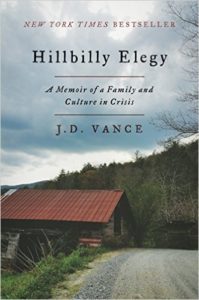 J.D. Vance’s book is a memoir of growing up in a family whose roots are of Scots-Irish decent in Appalachia. His family’s history is one of enduring poverty and hardship. He tells stories about his life growing up in a tumultuous home that is at times normal, humorous, and humanizing, but also one that is graphic, disturbing, and unpredictable. Life growing up in Appalachia might leave a person open to harsh criticism and stereotype, yet the author Vance reveals his childhood and upbringing to make a clear distinction between perception and reality. J.D. Vance’s story is of the struggles of white working class Americans in the post-industrial United States. He offers a message of hope by writing his story of how he went from growing up poor in Ohio’s Rust Belt, to spending time in schools in Kentucky and Ohio, serving in the Marines, graduating from college, and on to Yale Law School.
J.D. Vance’s book is a memoir of growing up in a family whose roots are of Scots-Irish decent in Appalachia. His family’s history is one of enduring poverty and hardship. He tells stories about his life growing up in a tumultuous home that is at times normal, humorous, and humanizing, but also one that is graphic, disturbing, and unpredictable. Life growing up in Appalachia might leave a person open to harsh criticism and stereotype, yet the author Vance reveals his childhood and upbringing to make a clear distinction between perception and reality. J.D. Vance’s story is of the struggles of white working class Americans in the post-industrial United States. He offers a message of hope by writing his story of how he went from growing up poor in Ohio’s Rust Belt, to spending time in schools in Kentucky and Ohio, serving in the Marines, graduating from college, and on to Yale Law School.
J.D. Vance, born in Middletown, Ohio,, moves frequently among homes in Ohio to Jackson, Kentucky. Vance describes his grandparents, Mamaw and Papaw, as the people in his life that offer him stability amid the craziness of his home life with his unstable mother. His grandparents marry in their early teens, leave Kentucky, and like many others travel the “hillbilly highway” from Appalachia to take jobs in the Midwest’s industrial hubs. They settle in Middletown, Ohio where his Papaw finds good paying work as a mechanic. Both grandparents have many personal problems while raising their three children, but both love their children and grandchildren.
The author writes that it is his grandparents and other white-working class peoples’ hope that their jobs will propel the next generation. J.D. Vance tells of the decline of jobs in Ohio Rust Belt for the next
forty years and the effect on the future generations of white-working class groups.
While J.D. Vance achieves the American Dream, he recognizes that others in similar situations need guidance and mentors. His is an important message about the keys to reaching the American Dream.
Hillbilly Elegy is an informative read into the current discussion of the challenges facing white-working class people. The personal narrative is that even a poor hillbilly from the rust belt can achieve the American Dream. Family, mentors, school support, government programs are important, but personal responsibility is the key.
Barbara’s Pick
October 2016
Before the Fall
Noah Hawley
Published May 31, 2016
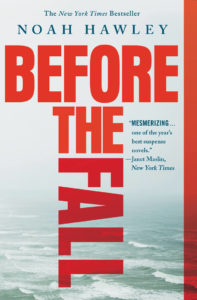 If you don’t read the cover (or dust jacket, if you are old-fashioned and buy the hardcover book), you may be surprised that at the end of the first chapter all but two of the characters you have just met are killed in a plane crash between Martha’s Vineyard and Teterboro. The only survivors—a past-his-prime painter whose specialty is painting disasters (like tornadoes and, yes, plane crashes) and the four-year-old son of a Fox News-like executive—escape the wreckage together, the painter putting the child on his back and swimming to Montauk.
If you don’t read the cover (or dust jacket, if you are old-fashioned and buy the hardcover book), you may be surprised that at the end of the first chapter all but two of the characters you have just met are killed in a plane crash between Martha’s Vineyard and Teterboro. The only survivors—a past-his-prime painter whose specialty is painting disasters (like tornadoes and, yes, plane crashes) and the four-year-old son of a Fox News-like executive—escape the wreckage together, the painter putting the child on his back and swimming to Montauk.
This novel—part mystery, part character study, and part survivor story—is constructed in a very interesting way. It alternates between the survivors’ stories and the story of each person who died. Each chapter explains a previous one, providing a compelling reason to not put the book down. From the reviews I’ve read, many readers finished the book in one or two sittings, as I did.
There was a slight twist at the end that may disappoint some readers, but all in all I felt this book was successful in portraying our fascination with luxury travel, 24-hour news, dirty financial dealings, and the ultimate redemption of a flawed protagonist.
Karen’s Pick
September, 2016
The Underground Railroad
Colson Whitehead
Doubleday, NY 2016
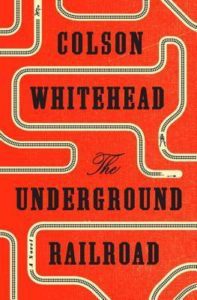 As a fan of historical fiction, I was eager to read Colson Whitehead’s new novel The Underground Railroad depicting one of the most difficult periods of American history, slavery in the antebellum south.
As a fan of historical fiction, I was eager to read Colson Whitehead’s new novel The Underground Railroad depicting one of the most difficult periods of American history, slavery in the antebellum south.
The story begins with the brutal voyage of African men and women to the United States of America. We all know the horrors that are associated with the American slave trade, but little prepares us for the graphic accounts of the results of the sanctioned ownership of a person.
Mr. Whitehead’s story is about the dehumanization of black people in the 1800s, for the sake of stability of the cotton and tobacco industries. Our emotions are rubbed raw with how the slave owners and slave catchers rationalized their actions, to promote the economic agendas of the country at ANY cost. If this subject isn’t enough for one author to handle, the emotionally charged trigger issues of religion and manifest destiny are also laced throughout the book.
The reader will discover that Whiteheads route to freedom is unlike the historically accurate Underground Railroad of the era, but that of a web of underground tunnels with kind station agents, platforms, tracks and locomotives to help take escaped slaves to their final destinations. However, along the way, each of the terminuses reflect the evil bred by the climate of slavery.
The story is told mainly from the perspective of a young slave woman named Cora determined to flee plantation life and her ultimate journey toward freedom via Whitehead’s fantasy railroad. Cora’s attempt to be free allows us to better understand the relationship of anguish and despair to that of hope and courage.
At times, the allegorical use of Whitehead’s underground railroad was disruptive to the readers’ emotional connection to the story. Tables set with white cloths, flowers, and freshly baked bread make for a jarring contrast to the reality of the ordeal we know as being true, albeit, giving us a moment when we begin to believe that all is going to be okay.
Be prepared, Whitehead’s story becomes more potent after closing the book. Cora’s plight will haunt you and force the question of slavery and the persistence of systemic racism in America.
This is powerful and important book. I (highly) recommend Colson Whitehead’s The Underground Railroad to those willing to confront the dark subject of slavery as part of this nation’s history.
Bill’s Pick
August, 2016
The Second Life of Nick Mason
Steve Hamilton
G. P. Putnam’s Sons, NY (2016)
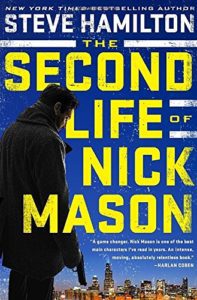 Nick Mason, from Chicago’s South Side, was sent to prison for 25 years on a felony-murder charge arising from his role in a criminal operation that resulted in a death. Five years into his sentence, Mason gets an offer that enables his release – but it comes at great cost. Once outside, Mason has to answer the cell phone he is provided, whenever it rings, and carry out whatever action is instructed. This is the deal Mason made with Darius Cole, the head of a criminal enterprise run from the prison where both were incarcerated.
Nick Mason, from Chicago’s South Side, was sent to prison for 25 years on a felony-murder charge arising from his role in a criminal operation that resulted in a death. Five years into his sentence, Mason gets an offer that enables his release – but it comes at great cost. Once outside, Mason has to answer the cell phone he is provided, whenever it rings, and carry out whatever action is instructed. This is the deal Mason made with Darius Cole, the head of a criminal enterprise run from the prison where both were incarcerated.
As Nick is drawn deeper into the operation with increasingly more violent assignments, he looks for a way out, hoping to begin a new life and to rebuild his relationship with the young daughter left behind with his now ex-wife and her new husband. Along the way, Mason reconnects with a boyhood friend from the Canaryville neighborhood where they grew up, is pursued by a detective who wants to put him back in prison, and encounters two women – one with a connection to Cole and the current arrangement, and the other someone he wants to believe in him. Mason ultimately decides that he has to regain control of his life and to go back on the deal that brought him “freedom.’’ That decision puts his life and those of others in potential danger.
The story moves at a fast pace and the characters well-sketched, especially Mason, who is troubled by his choice from the start. Background and plot are believably constructed, with some interesting twists. The novel is one that can be read in a single sitting – if you are so inclined – but, in any event, it is not easily put down. This is a good book for the beach or a rainy summer night.
Steve Hamilton is an award-winning mystery novelist.
Chris’s Pick
July 2016
The Broken Shore
Peter Temple, published 2005
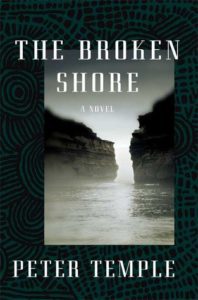 This is a first for me. The Broken Shore is a “crime novel” so I read it as such for the story, got to the end, said (to myself) “What?”, turned back to page one and read it completely through a second time. This time, though, I paid attention to the way this masterful book is written, realizing I had just discovered an exciting author (though he has long been recognized in Australia as one of the its nations finest).
This is a first for me. The Broken Shore is a “crime novel” so I read it as such for the story, got to the end, said (to myself) “What?”, turned back to page one and read it completely through a second time. This time, though, I paid attention to the way this masterful book is written, realizing I had just discovered an exciting author (though he has long been recognized in Australia as one of the its nations finest).
The first sentence should have alerted me:
Cashin walked around the hill, into the wind from the sea. It was cold, late autumn, last glowing leaves clinging to the liquidambars and maples his great-grandfather’s brother had planted, their surrender close. He loved this time, the morning stillness, loved it more than spring.
Set on the rural coast of Victoria, Australia, much of the novel seems dedicated to giving the reader a sense of this place. The vast space, the silence, the economic destitution of the town, the hopelessness of the inhabitants, the political corruption, are so skillfully drawn they are etched indelibly in the reader’s mind.
Cashin is a cop, sent from a big city Homicide division to his boyhood home to recover from serious injuries inflicted by a madman. Although we know that Cashin lives in chronic pain, whatever else we learn about him is through intimation, surmise, off the cuff conversation. Peter Temple does not lay out a background for the reader. The whole book is a detective story for the us to determine who, why, when, and what is going on—certainly if you miss a detail, Temple does not go back to explain it to you again. To further the care and patience one must have to enjoy this writer, it is written in an Australian dialect—so much so that there is a glossary of terms at the end of the book to help discern what is being said.
The plot and story line are almost secondary to Temple’s depiction of Australia as a violent, bitterly divided nation. A wealthy elderly citizen is beaten to death in his home, and three teenage “Abos”—Aborigines—are charged with the crime; deep-seated prejudice against Aborigines is central to the novel. Cashin becomes unconvinced of their guilt, and the story takes off from there.
The characterization of Cashin develops throughout the book. We know immediately that he loves opera and Joseph Conrad, and takes enormous pleasure in his two large unclipped black poodles. The two dogs are delightful characters in their own right:
The dogs arrived from a mission in the valley, greeted Cashin with noses and tongues, then left, summoned to some emergency — a rabbit rescue perhaps, the poor creature trapped in a thicket.
We learn there are endless personal problems that Cashin deals with: a difficult history with his mother, a suicidal brother, an ex-girlfriend who will not let him see his son. There are endless subplots and characters in the book. We meet at least a dozen people important to the story, from a swagman, helping Cashin try to restore his grandfather’s ruin of an estate, to Cashin’s boss, Villani, to his aboriginal partner, Dove, to his mentor, Singo, at the end of his life in a nursing home.
In the end, though, it is the writing, at once emotive and eloquent, then crude and stark, that stays with you. There is a fair amount of blood and gore and expletives, so beware if this offends. But Temple combines this with poeticism even within the brutality. It is one of the most interesting books I have (twice) read this year.
Pete’s Pick
June 2016
Washed Away: How the Great Flood of 1913, America’s Most Widespread Natural Disaster, Terrorized a Nation, and Changed it Forever
Geoff Williams, Published 2013
Introduction
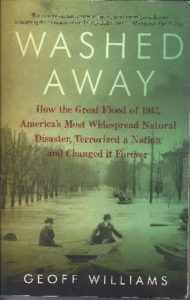 This book is an extraordinarily researched story of a national disaster not well known in the country’s history. It recounts the story of this disaster from the setting of many different communities in 14 states and dozens of people whose lives are changed as a result.
This book is an extraordinarily researched story of a national disaster not well known in the country’s history. It recounts the story of this disaster from the setting of many different communities in 14 states and dozens of people whose lives are changed as a result.
Author
Geoff Williams is also the author of C.C. Pyle’s Amazing Foot Race: The True Story of the 1928 Coast-to-Coast Run Across America and is a journalist for several news wires including Reuters and random publications such as Huffington Post and CNNMoney.com.
Story
This book tells the story of the most widespread natural disaster the country has experienced in which more than 1500 people lost their lives across 14 states. However, it is a little-known national disaster as it tended to be referred to locally, i.e. the Great Dayton Flood of 1913.
Over the span of some 300 pages, Williams reports a well-researched story of tragedy and heroism during the last week of March 1913. Starting with the outbreak of tornadoes in Omaha, NE on Easter Sunday, March 23, followed by torrential rains which inundated Ohio, Indiana, Pennsylvania and caused major flooding of every river east of the Mississippi by the end of that week, Williams tells the incredible stories of heroism and tragedy. It is a heart-thumping page turner as we are carried back and forth between Omaha, NE; Dayton, OH; Fort Wayne, OH; Indianapolis, IN; Columbus, OH; Peru, IN; New Castle, PA and many other communities over the course of six days. We follow the heroic efforts of numerous individuals we come to know. We follow Sam Bundy who worked nonstop for 57 hours rescuing well over 100 individuals. John Bell spliced together and maintained the only telephone link between Dayton, OH and the outside world. Thomas Green was Ohio Governor James Cox’s telephone operator and kept him in contact with communities and governmental agencies. We meet John Patterson, founder of National Cash Register Company, who provided his corporate facility as a refuge center and provider of supplies and equipment including 167 row boats built in his shops and used in rescue operations in Dayton, OH. Geoff Williams takes us through these six days hour by hour going from one location to another and back again as the story unwinds. We become caught up in the stress and anxiety, horror and joy of each person’s experience. We are saddened by so many deaths and rejoice at the countless rescues that are recounted during each hour of each day.
The story Williams recounts is also the story of how the absence of any national program for disaster relief or for flood control, and how the absence of the kind of communications capabilities we so take for granted today impacted millions of people from Nebraska to Vermont during this last week of March 1913. As a result of these experiences, a national flood control system was developed which in the 100 years since the disaster has proven its worth many times. Finally, in the Epilogue we are able to see how the story ends for many of these folks we have gotten to know. It is a story of challenge, of resourcefulness, of innovation, of incredible luck, and of heroism that leaves us gasping in anticipation and clapping with exuberance as story after story takes place.
Evaluation
This is a well-documented account of a little known yet significant national disaster which gave rise to much of the flood control measures that are in use in the country today. It recounts in exquisite fashion the stories of dozens of people who died or were rescued or did the rescuing during an intense weather phenomenon not matched again until Hurricane Katrina and more recently Hurricane Sandy.
I highly recommend it.
Arnie’s s Pick
May 2016
The Houses That Sears Built
Rosemary Thornton
2002
 Early in the 20th century, Sears building materials manager, Frank Kushel, suggested that Sears assemble kits of all the parts needed for entire houses through mail order. Sears first specialty catalog, Book of Modern Homes and Building Plans, was published in 1908, offering 44 designs at costs from $360.00 to $2890.00.
Early in the 20th century, Sears building materials manager, Frank Kushel, suggested that Sears assemble kits of all the parts needed for entire houses through mail order. Sears first specialty catalog, Book of Modern Homes and Building Plans, was published in 1908, offering 44 designs at costs from $360.00 to $2890.00.
From 1908 until 1940 Sears sold kit homes that were assembled from coast-to-coast and from Alaska to Florida, although the majority were built in the Midwest and on the east coast. Early kits required cutting lumber to required lengths, but after 1916 lumber was pre-cut to the exact required lengths. Kits shipped by railroad and then about 25 tons of materials were trucked to the building lot. Many were assembled by the prospective homeowners, often with the help of friends and neighbors like an old-fashioned barn raising.
Eventually, Sears offered almost 400 designs and allowed customers to alter dimensions and make design changes to existing designs. Home ownership was made easier by Sears mortgage loans, typically at 6% to 7% interest for fifteen years. Other companies, including Montgomery Ward and the Aladdin Company of Michigan, also offered kit homes in the early 20th century.
Author Rosemary Thornton is a Virginia native whose early employment was in real estate. She developed an interest in kit houses, Sears-provided in particular. Her first book, “The Reality of Real Estate,” was published in 1993 and “The Houses That Sears Built” is her second book, followed by “Finding the Houses that Sears Built.” Sears kit parts were produced in Illinois, Ohio, and Newark, New Jersey. Sales offices were nationwide, including Plainfield, New Jersey, so there are many Sears kit homes nearby.
Rosemary Thorton’s book is well written, nicely illustrated with photos, floor plans, Sears catalog pages, and early advertising. A fun read!
Nouhad’s Pick
April 2016
The Moor’s Account
Leila Lalami
Pantheon Books 2014
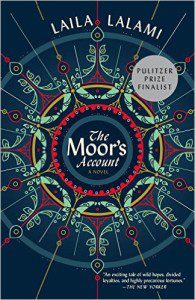 The story is a fictional account of the historical trek to the Gulf area of Florida. It is told by a Moroccan (Moor) slave who accompanied a group of Spanish conquistadors in the early 1500s. Estebanico (ne Mustafa ibn Muhammad) tells how he sold himself as a slave to help his family from starvation only to end up with a Spanish expedition in search of gold and colonization of new territory in the name of the Spanish Crown.
The story is a fictional account of the historical trek to the Gulf area of Florida. It is told by a Moroccan (Moor) slave who accompanied a group of Spanish conquistadors in the early 1500s. Estebanico (ne Mustafa ibn Muhammad) tells how he sold himself as a slave to help his family from starvation only to end up with a Spanish expedition in search of gold and colonization of new territory in the name of the Spanish Crown.
After a long and arduous journey, they found La Florida and went in search of food and inhabitants. They met up with various native tribes, each with its own set of rules and languages. Estebanico (Mustafa) tells of their trials with the tribes and the hardships of navigating the land. With hunger and disease, the only survivors were Estebbanico and three others. Many natives were also sickened and died. Mustafa tried herbs he learned from his mother and succeeded in a cure. This ability became the way to win over some natives and helped them gain some tribal respect.
The story is an accounting of the expedition, its hardships and survival, relationships with the natives and Mustafa’s constant hope for his freedom and return to his home. It is also a reminder of the daring men took in uncharted seas to find the new land, and the role slaves played in its settlement.
I chose this book with the recommendation of my sister. I found myself engrossed in its adventure, and historical information.
Nancy’s Pick
March 2016
The Girl on the Train
Paula Hawkins; published January, 2015
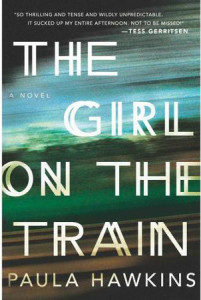 The Girl on the Train is part thriller and mystery. The views from the train are the English countryside, houses, gardens, businesses and people. The setting of The Girl on the Train takes place on a train. The three main characters imagine events about the lives of the real people that they observe along the track. Curiosity gets the better of them and the events in the book become a thriller and mystery.
The Girl on the Train is part thriller and mystery. The views from the train are the English countryside, houses, gardens, businesses and people. The setting of The Girl on the Train takes place on a train. The three main characters imagine events about the lives of the real people that they observe along the track. Curiosity gets the better of them and the events in the book become a thriller and mystery.
The author fills the pages with clues, but the clues often escape the reader, only to catch up with you later. The reader gets to know the characters, their motivations, and actions. The Girl on the Train‘s mystery captures the reader to want to finish the book quickly. The author, Paula Hawkins, adds an unexpected twist to the ending!
Bill’s Pick
February 2016
The Verdict
Nick Stone
Pegasus Crime, New York, NY (2015)
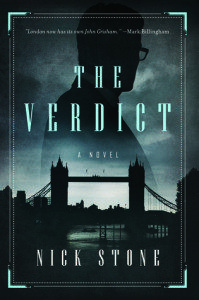 Nick Stone’s most recent novel, The Verdict, is set in London. Terry Flynt is a legal clerk working at a large firm, Kopf-Randall-Purdom (KRP). Hired on initially as a temp in the firm’s criminal group, Terry is trying to move up to a paralegal position and the fully funded law degree that the firm awards periodically to its best clerk. The problem is that the criminal group – which is small in size and brings in less in the way of billings than the corporate and tax groups – has never had a clerk win the award. Flynt is hopeful that that might change with Janet Randall in charge. Randall is seeking to expand the size and influence of the criminal practice section.
Nick Stone’s most recent novel, The Verdict, is set in London. Terry Flynt is a legal clerk working at a large firm, Kopf-Randall-Purdom (KRP). Hired on initially as a temp in the firm’s criminal group, Terry is trying to move up to a paralegal position and the fully funded law degree that the firm awards periodically to its best clerk. The problem is that the criminal group – which is small in size and brings in less in the way of billings than the corporate and tax groups – has never had a clerk win the award. Flynt is hopeful that that might change with Janet Randall in charge. Randall is seeking to expand the size and influence of the criminal practice section.
When Flynt gets the opportunity to work on a major case involving a wealthy financial executive accused of murdering a woman in his hotel suite, Flynt’s prospects for getting the award seem to improve significantly. But the assignment puts him in the cross-hairs of other clerks in the firm and forces him to confront his past. The executive charged with the murder, Vernon James, is a childhood friend of Flynt. The evening before being arrested for murder James was awarded the Ethical Person of the Year by an international organization. At his trial, the barrister representing James tells the court:
I don’t like him one bit. I don’t think he’s what you’d call a “nice person,” or a ‘’good person.” Over the course of the trial, I expect you’ll agree.
Twenty years earlier, James betrayed his friendship with Flynt, and Terry has waited for the day when he might get revenge. At stake, however, are not only James’s freedom, Terry’s career, and the choices that Terry must make as he participates in the investigation of the case, but also the integrity of the firm and judicial system.
Stone has developed an interesting group of characters, plot elements, and lines of attack as the story moves through the alleged crime, the selection of counsel, the background of the relationship and conflict between Flynt and James, the investigation, and finally to the preparation for and trial itself. Things move along at a fast pace; the writing is crisp; and the story holds your attention. The Verdict could be just what you need for a dark, wintry weekend.
Nancy's Pick
January 2016
Brooklyn
Colm Tóibín
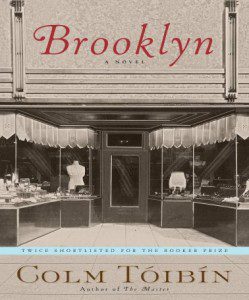 Brooklyn, by author Colm Tóibín, is a fictional novel set in the 1950’s in Brooklyn, New York. The main character is a young Irish girl, Eilis Lacey, who is newly arrived in America. Eilis, sponsored by a priest in New York, is to work in an upscale department store. She sadly leaves behind her mother and sister who hope that she will return to Ireland one day.
Brooklyn, by author Colm Tóibín, is a fictional novel set in the 1950’s in Brooklyn, New York. The main character is a young Irish girl, Eilis Lacey, who is newly arrived in America. Eilis, sponsored by a priest in New York, is to work in an upscale department store. She sadly leaves behind her mother and sister who hope that she will return to Ireland one day.
Her small village in Ireland is so different from the busy crowded NY city. The author writes about her adjustment to the occupants and the rules of a ladies only rooming house and her job requirements. Eilis encounters many ethnicities in her job, her daily life, and in her social activities. Toibin engages the reader to follow the life of a lonely young Eilis Lacey as she pursues opportunities at Brooklyn College and meets a young Italian boy from a poor caring family at an Irish dance. The author slowly and carefully writes about their courtship and a secret. Eilis has a call that her beloved sister died and she returns to Ireland to help her mother.
While back in Ireland the author details Eilis’s return and the possibilities of a permanent stay. The novel is a quick read and the reader cheers Eilis to make the right choice about returning to America. The novel is in the theaters and is a romantic themed movie. Brooklyn, the movie, captures the highlights of the book and the charm of Eilis. I suggest reading the book before seeing the film to enjoy Colm Toibin’s writing style and his ability to convey so many emotions.